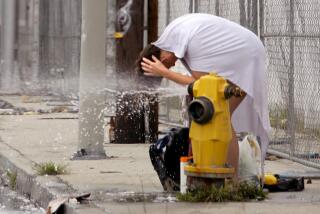Health Officials Defend Procedures
Los Angeles County health officials said Tuesday that their failure to publicize a recent Legionnaires’ disease outbreak at a hospital was an isolated incident.
Dr. Thomas Garthwaite, director of the Department of Health Services, told the county Board of Supervisors that he has reviewed all disease outbreaks from the past year and concluded that his agency is not withholding information from the public about any major health concern.
Garthwaite and his staff have been sharply criticized by supervisors for the department’s handling of the Legionnaires’ outbreak at Good Samaritan Hospital in downtown Los Angeles between January and June.
Nine people became infected with the respiratory ailment at the hospital, including two who later died. Good Samaritan officials have said the two infected patients who died had serious heart problems, and that Legionnaires’ disease did not play a role in the deaths.
No new Legionnaires’ infections have been reported at Good Samaritan since last month. Health officials said they knew of no clusters of Legionnaires’ infections anywhere else in the county.
Legionnaires’, which can cause death in 5% to 30% of cases, cannot be transmitted from person to person. Patients contract the disease by inhaling water droplets or mist contaminated with the Legionella pneumophila bacteria. Some research has suggested that air-conditioning units, showers, water towers and mist machines spread the bacteria.
While he said authorities should have alerted the public sooner, Garthwaite also said that his department’s acute communicable disease control unit responded swiftly and appropriately.
That unit worked with the hospital to take such steps as testing and decontaminating its water system, serving bottled water to patients and changing some shower heads.
“We’ve got some real smart people,” Garthwaite said. “They were just doing their job, not thinking about the public notification issue.”
Some county public health workers still maintain that the public did not need to be notified of the outbreak. The county acknowledged the cluster at Good Samaritan on June 30 after The Times learned of it through an anonymous tip.
The outbreak “did not threaten the health of either the general public or visitors to the hospital,” wrote Dr. Shirley Fannin, director of disease control programs, in a letter to the supervisors’ offices. “This hysteria about Legionella infection from one location is very misplaced” because steps were taken to contain it.
Good Samaritan is in the process of notifying all new patients about its response to the cases.
The hospital attempted unsuccessfully to eliminate the Legionella bacteria from its water system in June by performing a superheated flush. The hospital is awaiting lab results on whether a chlorine flush last week was enough to get rid of the contamination.
County officials say Good Samaritan properly reported the cases of Legionnaires’ to the county, but other hospitals may not be following the law.
More to Read
Sign up for Essential California
The most important California stories and recommendations in your inbox every morning.
You may occasionally receive promotional content from the Los Angeles Times.










